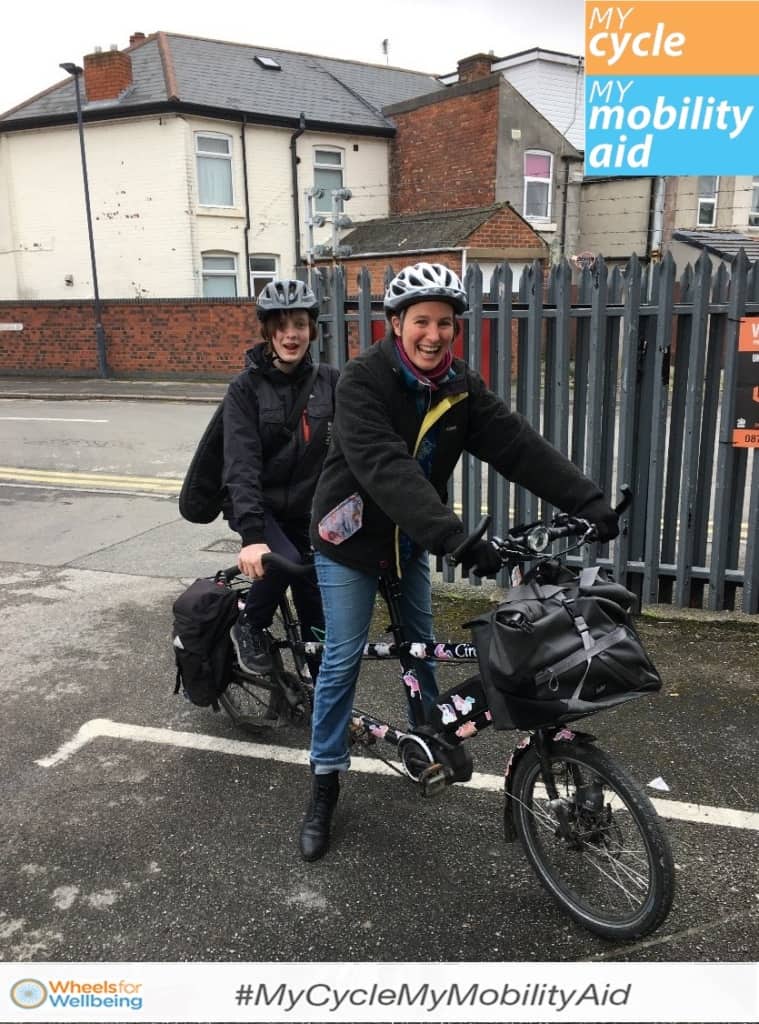In this blog Kate from Derby tells us in her own words about how a tandem e-cycle is the essential mobility aid in her family and the barriers they face to cycling.

“This is me and my 12-year-old on my e-tandem, really it’s mine and my 10-year-old daughter’s bike but all 6 of our family love it! The 50 unicorn stickers and spokey dokeys are very much her way to mark her property though!
I have arthritis in my back which causes a lot of pain and makes walking very hard. The grey bag on the front of the bike contains my folding crutches and I can no longer ride without a motor to help me out. My daughter is learning disabled and autistic. She loves cycling and can balance fine but can’t make decisions about steering and stopping reliably enough to control her own cycle. The two of us together love this tandem! The freedom it gives us is fantastic, and it’s something we can do together since I can no longer do most of the really physical things (like orienteering) that she prefers to do.
Our tandem gets us everywhere: school runs, shops, clubs, the lot. We live in a city, so we can usually get door-to-door way faster than we could in a car and we can usually park closer to where we want to be as well (with a few notable exceptions). Our school run involves getting right across the city centre between a special school and a mainstream school each day, something many parents of disabled children face. It’s not possible to do it fast enough in a car due to congestion and parking issues, but we do it with 10 minutes to spare by cycling!
However, we encounter barriers every single time we’re out riding: tight chicanes, badly placed bollards, missing or blocked drop kerbs, drivers who get aggressive about overtaking or drive straight at us on narrow streets, crossings with central sections so narrow we block them entirely and prevent mobility scooters from crossing the other way. It’s even trickier when riding with our 8-year-old, we have to ride two abreast most of the time and drivers often get impatient waiting for us to find a gap in parked cars so we can let them pass safely. We end up pavement riding some sections because our acceleration is poor and because fast, busy roads are not suitable for any child to ride on. We do always stop for pedestrians but it still feels really awkward.
It would help us so much to have cycles recognised as mobility aids, in the same way everywhere has signs to allow assistance dogs. I’m able to walk a bit but pushing the bike really hurts and I can’t push while using crutches anyway. Just being able to roll to where we need to go even on pedestrianised spaces without being glared at or told to dismount would make trips out so much less stressful. I’m not eligible for a blue badge as I can walk more than 100m (very slowly and uncomfortably) so a similarly strict scheme for registering disabled cycles would be no good to me, but still I need to be able to get from my door to suitable cycle parking without having to get on and off the tandem.”
Kate and her family’s experiences demonstrate how and why cycles are essential mobility aids for many Disabled people. We will continue to campaign for legal recognition of cycles and mobility aids and we are paying close attention to some pilot schemes that are being rolled out in the next months by a number of local authorities as part of the Gear Change programme.
#MyCycleMyMobilityAid
